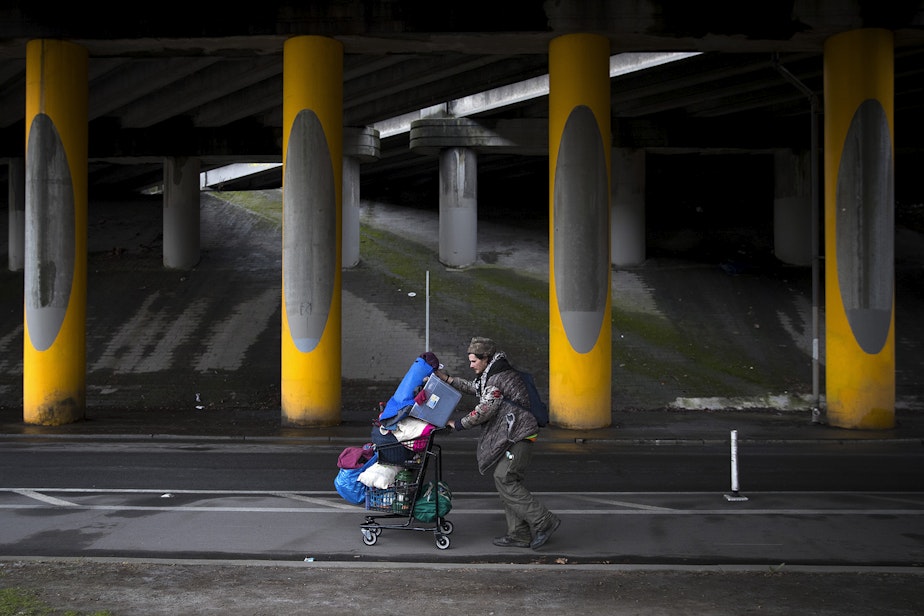How did one Seattle ‘unhoused to hotels’ program work? The results are mixed

At the beginning of the pandemic, Seattle and King County tried a new approach to get people living in homeless encampments into stable housing. They started putting people up in hotels, with the ultimate goal of keeping people off the streets. Some new data suggests that approach may not be a silver bullet in solving the issue.
Seattle Times reporter Sydney Brownstone has been reporting on the efforts of a coalition called JustCARE. She told KUOW’s Kim Malcolm about what happened to the residents of an encampment at Eighth Avenue South and South King Street in Seattle.
This interview has been edited for clarity.
Kim Malcolm: This new approach was, "We're not here to clear you out. We'd like to offer you your own hotel room." How did that go over?
Sydney Brownstone: It went very well. I was at the King Street encampment with JustCARE outreach workers. There were people walking up asking, "Hey, can I get a hotel?" It was really different from what I had seen previously. In the past, the navigation team, or city staffers, or police would come in and say, "You have to get out, but here's what we can offer you." It was congregate shelter, or basic emergency shelter. People would say, "No, thanks. I can't take my stuff there. I don't feel safe there. My partner can't be there. My dog can't be there." There were a lot of reasons people had for preferring to stay outside.
But with hotel rooms, it was actually something that people wanted. This initial experiment with the South King Street encampment showed that before, the parking lot was clogged with tents, and after, all the tents were gone. And there wasn't police with a garbage truck and city workers coming in to say "You have to get out of here."
How many people actually took them up on that offer and went into a hotel room?
Sponsored
I don't have the hard number of people who were living at the encampment, but I do know that outreach workers evaluated 78 people at the encampment for hotel rooms, and 57 people came inside. That ratio is pretty big.
Flash forward, 10 months on, you decided to check back in on this. What happened to those 57 people who were placed in a hotel?
We know that at least 20 of them are gone, and probably back on the streets; 20 of them either left the program voluntarily, or they were kicked out because of safety issues, doing illegal things, violating the lodging agreement, or just not working with case management.
We don't know what happened to 16 of them. We know that six people got into permanent housing. For these kinds of shelter programs, that’s not bad, which says something about the shelter system itself. But if you look at the rate of unsuccessful exits, 20 out of 57, more than a third, that is extraordinarily high.
What are people learning about what worked in that scenario, and what didn't?
Sponsored
I think the first is that if you actually offer services that people want, the idea of service resistance kind of disappears. That's huge. The second thing is that there's a difference between addressing encampments, and addressing homelessness. If you are solely looking at this issue as "We have to clean up encampments," the solutions are temporary.
We got people inside, but then eventually they went back out onto the streets for a number of reasons. Also, the connection to permanent housing isn't a direct one. If we were trying to solve homelessness, we would be doing everything we could to get people into permanent housing and those resources have not been available to date.
So, there wasn't a clear path from the hotel room to permanent housing?
No. It's a pretty complicated path between a shelter and permanent housing. The program figured that maybe they could expedite this through something called "Rapid Rehousing" rental subsidy vouchers. Those are expected to be distributed to the program coming up, but the problem with these types of vouchers is that they're time limited. They only help you between six months and a year. For people who have been living on the streets for long periods of time, that might not be an appropriate intervention.
Listen to the interview by clicking the play button above.





